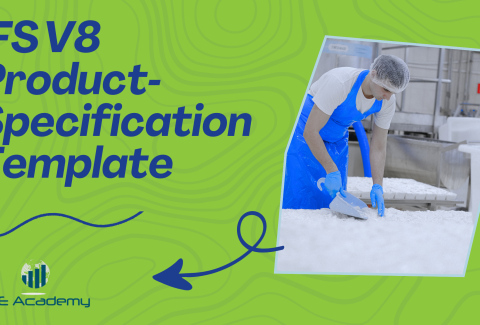IFS V8 Project‑Plan Template
Last Updated on November 18, 2025 by Melissa Lazaro
Why a Clear Project Plan Sets the Tone for Success
When teams start implementing IFS Food V8, the process can feel overwhelming. There are documents to update, processes to align, people to train, and improvements to schedule — and without structure, things fall through the cracks. I’ve seen strong teams struggle simply because everyone assumed someone else was responsible.
A well-built project plan keeps everything aligned. It gives your team clarity, accountability, and a realistic timeline. More importantly, it helps you avoid the last-minute scramble that usually happens three weeks before the audit.
If you’re preparing for certification, this template gives you a step-by-step structure you can follow and adapt to your site. You’ll know what needs to be done, who’s responsible, and when proof needs to be completed.
Define Scope, Timeline & Project Structure — Setting the Foundation Before Work Begins
Before you update a single document or schedule a training session, it’s important to define your scope clearly. This sets boundaries for the entire project.
Here’s what to include in this part of the plan:
- Certification scope
- Process/product group category under IFS V8
- Expected certification month or deadline
- Core team members and their responsibilities
- Meeting and communication structure
A quick tip: keep everything in one place — a shared drive, project platform, or QMS tool. When information is scattered in emails, notebooks, and memory, progress slows and confusion grows.
I’ve worked with teams who postponed certification by months because the scope wasn’t agreed upfront. Setting clarity now saves time later.
 Documentation Review & Development — Updating What Exists and Creating What’s Missing
Documentation Review & Development — Updating What Exists and Creating What’s Missing
IFS V8 requires controlled and traceable documentation. That means manuals, SOPs, records, forms, and templates must align with the latest version — not last year’s revision.
This section outlines:
- Which documents already exist
- Which need revision
- Which must be created from scratch
- Who owns each document
- Deadlines and file locations
A simple matrix works well here — especially if you color-code progress.
One client went from hundreds of disconnected Word files to a centralized document system mapped directly to IFS clauses. Not only did it simplify training, but it made audits smoother because everyone knew where to find evidence.
Operational Improvements — Turning Gap-Analysis Findings Into Action
Once the paperwork is aligned, it’s time to look at real-world practices. This section helps you track physical or procedural improvements.
Typical categories include:
- Hygiene zoning adjustments
- Allergen-management improvements
- CCP/OPRP control updates
- Calibration and preventive-maintenance scheduling
- Storage, layout, or segregation upgrades
Prioritize improvements based on risk and audit relevance — not convenience. Some fixes are quick wins; others may require budget approval or phased rollout.
A lot of sites make the mistake of focusing only on documentation. But IFS V8 is heavily evidence-driven, and auditors will follow the process from policy to practice.
Competency, Culture & Training — Making Sure People Can Apply the Standard
IFS V8 expects more than sign-off sheets. The goal is competence — meaning employees understand what they’re doing and why it matters.
This part of the plan tracks:
- Training programs by role
- Food-safety culture activities
- CCP/OPRP training and validation
- Internal audit training
- Leadership involvement and accountability
Small, frequent training touchpoints often work better than long classroom sessions. One manufacturer I supported introduced short daily food-safety moments during shift handovers — and internal audit findings decreased significantly within months.
Internal Validation & Verification — Checking That the System Works Before the Audit
This is where your implementation gets tested.
Include tasks like:
- Validation studies (where applicable)
- Internal audits (planned early, not last minute)
- Corrective actions tracking
- Management review
- Mock or pre-audit
Think of this as your rehearsal. If something doesn’t work now, you still have time to fix it — without stress or pressure.
A mistake I see far too often: internal audits performed a week before certification. That doesn’t leave time to correct anything meaningful.
Certification Preparation — Final Checks Before the Auditor Arrives
This final section makes sure everything is in place for the official audit.
Checklist items may include:
- Certification body confirmed and audit dates booked
- Evidence indexing complete
- Latest versions printed or accessible
- Meeting rooms, escort plans, and labelling controls prepared
- Team briefings and interview expectations reviewed
A short rehearsal audit — even if informal — builds confidence and improves response readiness.
Conclusion — Turning a Template Into Real Progress
A structured project plan keeps everyone aligned and removes guesswork from the certification journey. Once this framework is built, the next step is simple: assign owners, schedule milestones, and track progress consistently.
With the right approach, IFS V8 certification doesn’t have to feel overwhelming — it becomes a manageable, clear pathway.
Melissa Lavaro is a seasoned ISO consultant and an enthusiastic advocate for quality management standards. With a rich experience in conducting audits and providing consultancy services, Melissa specializes in helping organizations implement and adapt to ISO standards. Her passion for quality management is evident in her hands-on approach and deep understanding of the regulatory frameworks. Melissa’s expertise and energetic commitment make her a sought-after consultant, dedicated to elevating organizational compliance and performance through practical, insightful guidance.








